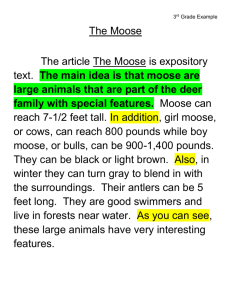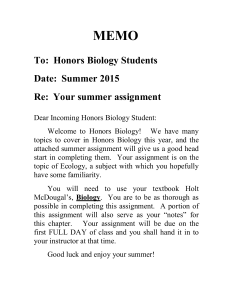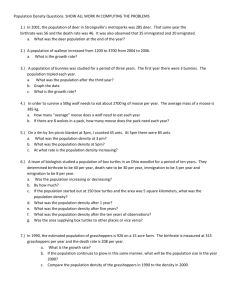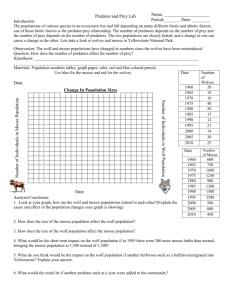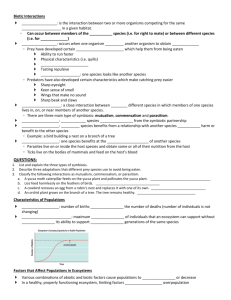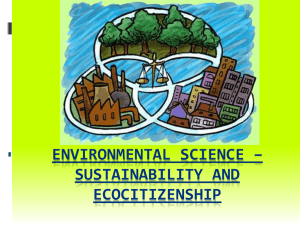Laboratory 1: Isle Royale
advertisement
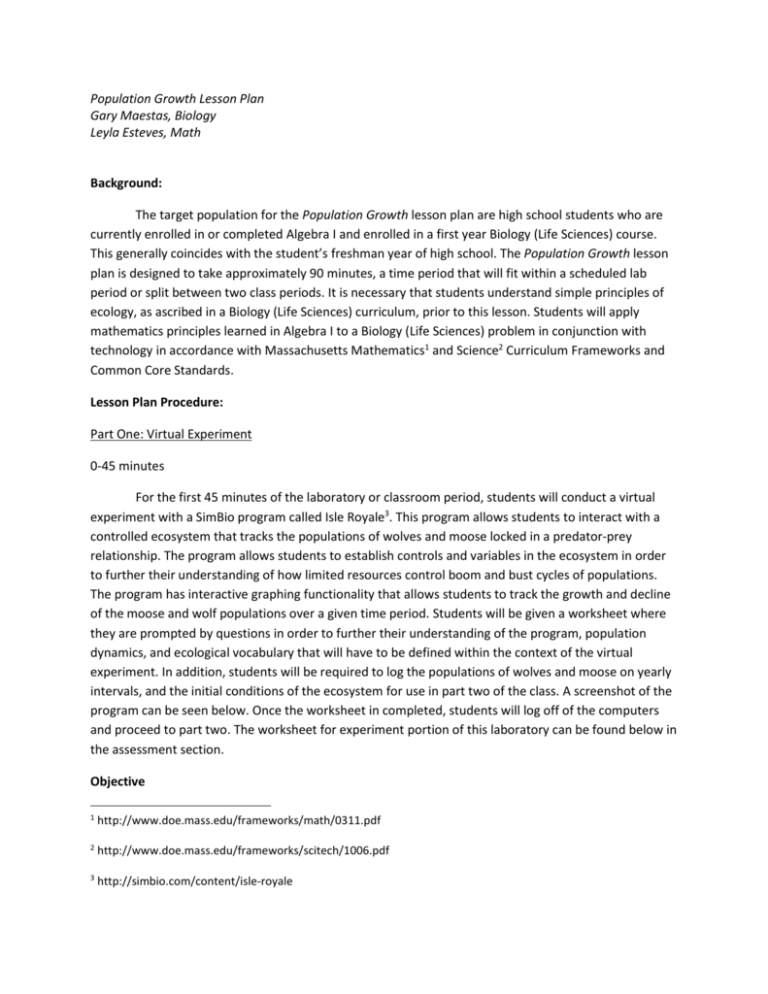
Population Growth Lesson Plan Gary Maestas, Biology Leyla Esteves, Math Background: The target population for the Population Growth lesson plan are high school students who are currently enrolled in or completed Algebra I and enrolled in a first year Biology (Life Sciences) course. This generally coincides with the student’s freshman year of high school. The Population Growth lesson plan is designed to take approximately 90 minutes, a time period that will fit within a scheduled lab period or split between two class periods. It is necessary that students understand simple principles of ecology, as ascribed in a Biology (Life Sciences) curriculum, prior to this lesson. Students will apply mathematics principles learned in Algebra I to a Biology (Life Sciences) problem in conjunction with technology in accordance with Massachusetts Mathematics1 and Science2 Curriculum Frameworks and Common Core Standards. Lesson Plan Procedure: Part One: Virtual Experiment 0-45 minutes For the first 45 minutes of the laboratory or classroom period, students will conduct a virtual experiment with a SimBio program called Isle Royale3. This program allows students to interact with a controlled ecosystem that tracks the populations of wolves and moose locked in a predator-prey relationship. The program allows students to establish controls and variables in the ecosystem in order to further their understanding of how limited resources control boom and bust cycles of populations. The program has interactive graphing functionality that allows students to track the growth and decline of the moose and wolf populations over a given time period. Students will be given a worksheet where they are prompted by questions in order to further their understanding of the program, population dynamics, and ecological vocabulary that will have to be defined within the context of the virtual experiment. In addition, students will be required to log the populations of wolves and moose on yearly intervals, and the initial conditions of the ecosystem for use in part two of the class. A screenshot of the program can be seen below. Once the worksheet in completed, students will log off of the computers and proceed to part two. The worksheet for experiment portion of this laboratory can be found below in the assessment section. Objective 1 http://www.doe.mass.edu/frameworks/math/0311.pdf 2 http://www.doe.mass.edu/frameworks/scitech/1006.pdf 3 http://simbio.com/content/isle-royale Students will learn about Ecology, one of the six subtopics covered in the learning standards for Biology at the high school level. Through the virtual experiment, students will learn about how births and deaths influence population size. Students will also learn about and define emigration and immigration and how they influence population size. (Science and Technology Curriculum Framework, p.56) Learning about Ecology is essential in allowing “students to make scientifically informed decisions related…to the health of the planet.” (Science and Technology Curriculum Framework, p. 42)4. Technology and Accommodations Students will use the SimBio program. The program has built in functionality for students with visual impairment. Visually impaired students have the option of magnifying the screen or data presented in audio format. 4 Massachusetts Science and Technology framework 2006 Assesment: The assessment of Part One: Virtual Experiment will be in the form of a worksheet. Please define the following terms within the context of the Isle Royale simulation (closed system): Emigration Immigration Carrying Capacity Use the following table to track wolf and moose populations Year Wolf population Moose population 0 1 2 3 4 Part Two 45-90 minutes Students will take their worksheet from part one and use their data to calculate growth rates over a given period of time. An equation modeling population growth is given, and the variables and constants are defined. The equation uses the natural logarithm function and the constant e to calculate population growth over a given time period for a constant growth rate. Students will use the population growth equation to calculate the total growth rate of both the wolf and moose populations over the full period, as well as the growth rates for intervals between local maximum and minimum points (these terms will be defined). Objective: Students will practice solving logarithmic equations as well as practice their graphing skills. (Math Curriculum framework p.84) Technology and Accommodation Students will use scientific calculators. Students also have the option of graphically representing their data with excel. For visually impaired students, a computer may be used to perform calculations. Assessment: (worksheet here) Please use the following equation to calculate the overall growth rate, r, for your SimBio wolf and moose populations (can be found on graph). 𝑷𝒇 = 𝑷𝒊 𝒆𝒓𝒕 𝑷𝒇 = 𝑷𝒐𝒑𝒖𝒍𝒂𝒕𝒊𝒐𝒏 𝒇𝒊𝒏𝒂𝒍 𝑷𝒊 = 𝑷𝒐𝒑𝒖𝒍𝒂𝒕𝒊𝒐𝒏 𝒊𝒏𝒊𝒕𝒊𝒂𝒍 𝒆 = 𝒄𝒐𝒏𝒔𝒕𝒂𝒏𝒕 (𝒐𝒏 𝒚𝒐𝒖𝒓 𝒄𝒂𝒍𝒄𝒖𝒍𝒂𝒕𝒐𝒓) 𝒓 = 𝒓𝒂𝒕𝒆 𝒐𝒇 𝒈𝒓𝒐𝒘𝒕𝒉 𝒕 = 𝒕𝒊𝒎𝒆 (𝒚𝒆𝒂𝒓𝒔) Example Calculation: Initial moose population (Pi): 2 Final moose population (Pf): 225 Years (t): 55 𝑷𝒇 = 𝑷𝒊 𝒆𝒓𝒕 𝟐𝟐𝟓 = 𝟐𝒆𝒓(𝟓𝟓) 𝟐𝟐𝟓 = 𝒆𝒓(𝟓𝟓) 𝟐 𝒍𝒏 𝟐𝟐𝟓 = 𝒍𝒏(𝒆)𝒓(𝟓𝟓) 𝟐 Remember, ln(e)=1! 𝒍𝒏 𝟐𝟐𝟓 = 𝒓(𝟓𝟓) 𝟐 𝟒. 𝟕𝟐𝟐 = 𝒓(𝟓𝟓) 𝟒. 𝟕𝟐𝟐 =𝒓 𝟓𝟓 . 𝟎𝟖𝟓𝟖 = 𝒓 Blibiography: Driscoll, David P. Massachusetts Science and Technology/Engineering Curriculum Framework. October 2006. Web. 4/24/13 Chester, Mitchell D. Massachusetts Curiculum Framework for Mathematics. March 2011. Web. 2/24/13
